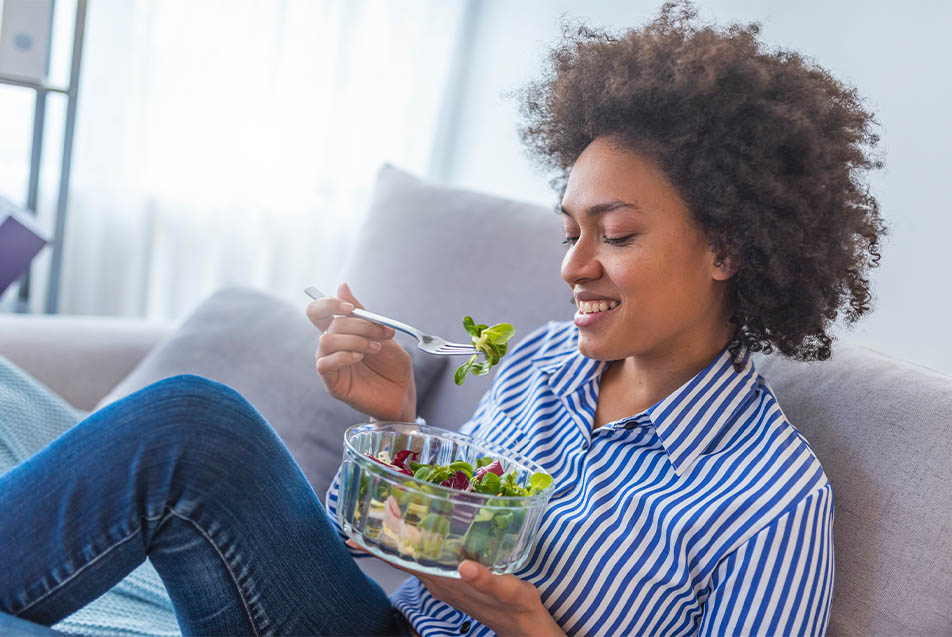
This post was written by Julia Walker, RDN, clinical dietitian, Parkview Health.
What you eat can affect your blood glucose, cholesterol, blood pressure and weight. But consuming a healthy, well-balanced diet doesn’t have to be difficult, especially for individuals with diabetes. Instead, those living with the condition should focus on when to eat, what to eat and how much to eat.
When
Eating at regular intervals can help control blood sugars and prevent any bouts of hypoglycemia. Consuming at least three meals each day, including breakfast, will help you feel satisfied while reducing your chances of overeating. However, it’s important that you eat at roughly the same time each day. Try eating a meal or snack every 4-5 hours throughout the day.
What
It might be hard to believe, but you don’t need to purchase special food if you have diabetes. The foods considered healthy for you are the same for everyone in your family. You can start by choosing a variety of high-fiber, heart-healthy foods each day, including fruits, vegetables, whole grains, beans and peas, low-fat dairy products, and quality protein such as fish, poultry and lean meats. Additionally, you’ll want to select healthy fats such as olive or canola oils instead of butter, shortening, solid fats or vegetable oils. You can also opt for other healthy fat sources such as nuts, seeds, and avocados in moderation. Try to limit or avoid sugar-sweetened drinks, sweets, baked goods, snack chips, fast food and other fried foods.
How much
Generally, our bodies change the food we eat into glucose (blood sugar) to supply the body with energy. However, someone with diabetes has a difficult time converting sugar into energy. For example, if you overeat, especially refined carbohydrates, your blood sugar may spike. But by eating smaller amounts of nutrient-dense, fiber-rich foods or carbohydrates and spreading your meals throughout the day, you can better control your blood sugar while also feeling healthier.
Try following these simple steps to help jumpstart your healthy eating efforts:
- Step 1: Grab a 9-inch dinner plate. Put a horizontal line across the middle of the plate, then put a vertical line down the middle of the top half.
- Step 2: Fill the bottom section with non-starchy vegetables like green beans, broccoli, cauliflower, tomatoes, carrots, spinach or lettuce.
- Step 3: Fill one of the two smaller sections with quality protein sources like fish, skinless chicken, lean beef or pork, eggs, low-fat cheese or tofu.
- Step 4: Fill the remaining smaller section with a healthy carbohydrate like whole grain bread, brown rice, corn tortillas, cooked beans, peas, corn or potatoes.
- Step 5: Be sure to include a serving of fruit and/or a low-fat dairy option in your meal.
- Step 6: Complete your meal with a low-calorie drink like water, coffee or unsweetened tea.

Final thoughts
If you have questions or are unsure of getting started, try reaching out to a registered dietitian nutritionist for help. They can point you in the right direction and help develop a meal plan that’s right for you and your specific needs.
Diabetes-friendly recipe
These vegan fajitas are perfect for a quick and tasty home-cooked meal any night of the week. Simply marinate and cook the vegetables, then serve them hot with your favorite fajita toppings.
Vegan Fajitas
Marinade
Vegetables
For serving
- Prepare vegetable marinade by combining all ingredients until thoroughly mixed.
- Slice peppers, onion and mushrooms. Place all vegetables into a large bowl.
- Add marinade and coat everything evenly. Set aside for 10 minutes.
- Heat a large nonstick skillet over medium heat to prepare toppings for serving.
- Add the marinated vegetables and cook until tender, about 5-7 minutes.
- Assemble your fajitas and enjoy!
- Store cooked vegetables in the refrigerator for up to three days. Reheat on the stovetop or in a microwave.
Nutritional facts (2 fajitas): 343 calories, 10g fat, 60g carbohydrates, 19mg sodium, 5g sugar, 8g fiber, 9g protein
Adapted from running on real food



